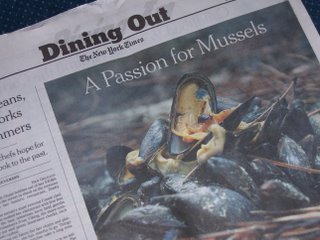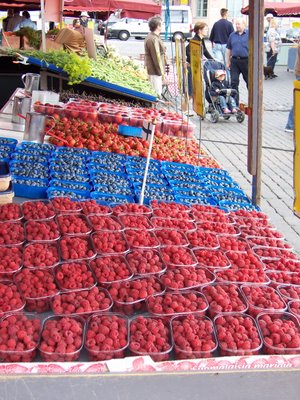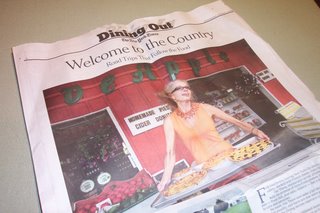
Mom opens the small manila envelope and slips a slightly faded photograph into my hand. “Do you remember this?” she asks. “I thought you might want to write about it.”
I pull out my reading glasses to take a closer look, and examine the photo of a 9-by-13 sheet cake. At the top, scripted in pale blue icing are the dates, 1932 – May 14th – 1983.
Mom studies my reaction, looking for a sign of recognition, and decides to jog my memory. “You made the cake for Grandma and Grandpa’s 51st wedding anniversary.” Indeed, on the back of the photo is Mom’s inscription: May 14th, 1983 – Anniversary Cake for Hilda & Steve Ernst – made by T. – 51 years married.
I see a bouquet of tiny blue and pink wildflowers, gathered together with a wavy pink ribbon. Not a bad effort for an amateur. I recall that it was actually one of the later cakes in my repertoire, and I had actually first cut my teeth on cake decorating in elementary school.
The memories come back to me, years before The Cake Doctor, The Cake Bible, Baking with Julia, the Magnolia Bakery or Martha Stewart’s Baking Handbook. I remember exploring Mom’s bookshelf and discovering a simple black and white volume on cake decorating. I was captivated by the photos of butter cream roses and scallop shell boarders. Mom had actually taken a cake decorating course years before and had all the tips and pastry bags stored away. We pulled them out, cleaned them all in hot soapy water, and looked them over. There were tips for rose petals, tiny blossoms and even branches with perfectly-shaped conical leaves.
In no time, Mom had connected me with Mrs. Becker, a pastry pro at our local church who gave me a lesson. Soon, I was whipping up celebration cakes for wedding anniversaries, birthdays and holidays. All this, before sixth grade graduation. Sometimes, the cakes were overly sweet, and sometimes, the colors a bit garish, but it was the start of creativity in the kitchen and a lifelong love of “le gateaux.”
If Mom hadn’t signed up for that first cake decorating course, I might never have paged through that text book and developed a taste for luscious layers.
Thanks, Mom, for the sweet inspiration!
© 2006 T.W. Barritt All Rights Reserved
I pull out my reading glasses to take a closer look, and examine the photo of a 9-by-13 sheet cake. At the top, scripted in pale blue icing are the dates, 1932 – May 14th – 1983.
Mom studies my reaction, looking for a sign of recognition, and decides to jog my memory. “You made the cake for Grandma and Grandpa’s 51st wedding anniversary.” Indeed, on the back of the photo is Mom’s inscription: May 14th, 1983 – Anniversary Cake for Hilda & Steve Ernst – made by T. – 51 years married.
I see a bouquet of tiny blue and pink wildflowers, gathered together with a wavy pink ribbon. Not a bad effort for an amateur. I recall that it was actually one of the later cakes in my repertoire, and I had actually first cut my teeth on cake decorating in elementary school.
The memories come back to me, years before The Cake Doctor, The Cake Bible, Baking with Julia, the Magnolia Bakery or Martha Stewart’s Baking Handbook. I remember exploring Mom’s bookshelf and discovering a simple black and white volume on cake decorating. I was captivated by the photos of butter cream roses and scallop shell boarders. Mom had actually taken a cake decorating course years before and had all the tips and pastry bags stored away. We pulled them out, cleaned them all in hot soapy water, and looked them over. There were tips for rose petals, tiny blossoms and even branches with perfectly-shaped conical leaves.
In no time, Mom had connected me with Mrs. Becker, a pastry pro at our local church who gave me a lesson. Soon, I was whipping up celebration cakes for wedding anniversaries, birthdays and holidays. All this, before sixth grade graduation. Sometimes, the cakes were overly sweet, and sometimes, the colors a bit garish, but it was the start of creativity in the kitchen and a lifelong love of “le gateaux.”
If Mom hadn’t signed up for that first cake decorating course, I might never have paged through that text book and developed a taste for luscious layers.
Thanks, Mom, for the sweet inspiration!
© 2006 T.W. Barritt All Rights Reserved

 Devouring The New York Times – August 30, 2006: Florence Fabricant wraps up a frank discussion of the return of pigs-in-a-blanket as the chic new appetizer in this week’s “Dining In” section.
Devouring The New York Times – August 30, 2006: Florence Fabricant wraps up a frank discussion of the return of pigs-in-a-blanket as the chic new appetizer in this week’s “Dining In” section.




 Work is concluded, and my host makes arrangements for us to dine at Savoy, a restaurant located just off of Esplanade Park. An elevator whisks us up to the eighth floor where we emerge on a wood and glass dining room of smooth lines and contours created by the noted designer Alvar Aalto. There is a wrap-around picture window that overlooks Helsinki, with brilliant views of the ocean and Helsinki Cathedral reaching into the sky.
Work is concluded, and my host makes arrangements for us to dine at Savoy, a restaurant located just off of Esplanade Park. An elevator whisks us up to the eighth floor where we emerge on a wood and glass dining room of smooth lines and contours created by the noted designer Alvar Aalto. There is a wrap-around picture window that overlooks Helsinki, with brilliant views of the ocean and Helsinki Cathedral reaching into the sky.













